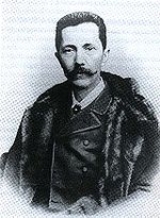
Giulio Bizzozero
Encyclopedia
Giulio Bizzozero was an Italian
doctor and medical researcher. He is known as the original discoverer of Helicobacter pylori
, the bacteria which is responsible for peptic ulcer disease (although this fact was not generally accepted until the 1990s). He was one of the early pioneers of histography, and, more generally, the use of the microscope
in medical research. He is also credited with the discovery of the function of platelet
s in the coagulation
of blood
.
Bizzozero was born in Varese, Lombardy
. He studied medicine at the University of Pavia
, graduating in 1866 at the age of 20. In 1867, he was chosen as the Chief of General Pathology and Histology at the University of Pavia. At the age of 27, he moved to the University of Turin
, and founded the Institute of General Pathology. This institute trained many important Italian researchers including Camillo Golgi
. While at Turin he worked to improve hygiene and water supply. In April 1901, he died of pneumonia
.
For his achivments works Bizzozero was named by king Humbert I life senator
in 1890.
Italy
Italy , officially the Italian Republic languages]] under the European Charter for Regional or Minority Languages. In each of these, Italy's official name is as follows:;;;;;;;;), is a unitary parliamentary republic in South-Central Europe. To the north it borders France, Switzerland, Austria and...
doctor and medical researcher. He is known as the original discoverer of Helicobacter pylori
Helicobacter pylori
Helicobacter pylori , previously named Campylobacter pyloridis, is a Gram-negative, microaerophilic bacterium found in the stomach. It was identified in 1982 by Barry Marshall and Robin Warren, who found that it was present in patients with chronic gastritis and gastric ulcers, conditions that were...
, the bacteria which is responsible for peptic ulcer disease (although this fact was not generally accepted until the 1990s). He was one of the early pioneers of histography, and, more generally, the use of the microscope
Microscope
A microscope is an instrument used to see objects that are too small for the naked eye. The science of investigating small objects using such an instrument is called microscopy...
in medical research. He is also credited with the discovery of the function of platelet
Platelet
Platelets, or thrombocytes , are small,irregularly shaped clear cell fragments , 2–3 µm in diameter, which are derived from fragmentation of precursor megakaryocytes. The average lifespan of a platelet is normally just 5 to 9 days...
s in the coagulation
Coagulation
Coagulation is a complex process by which blood forms clots. It is an important part of hemostasis, the cessation of blood loss from a damaged vessel, wherein a damaged blood vessel wall is covered by a platelet and fibrin-containing clot to stop bleeding and begin repair of the damaged vessel...
of blood
Blood
Blood is a specialized bodily fluid in animals that delivers necessary substances such as nutrients and oxygen to the cells and transports metabolic waste products away from those same cells....
.
Bizzozero was born in Varese, Lombardy
Lombardy
Lombardy is one of the 20 regions of Italy. The capital is Milan. One-sixth of Italy's population lives in Lombardy and about one fifth of Italy's GDP is produced in this region, making it the most populous and richest region in the country and one of the richest in the whole of Europe...
. He studied medicine at the University of Pavia
University of Pavia
The University of Pavia is a university located in Pavia, Lombardy, Italy. It was founded in 1361 and is organized in 9 Faculties.-History:...
, graduating in 1866 at the age of 20. In 1867, he was chosen as the Chief of General Pathology and Histology at the University of Pavia. At the age of 27, he moved to the University of Turin
University of Turin
The University of Turin is a university in the city of Turin in the Piedmont region of north-western Italy...
, and founded the Institute of General Pathology. This institute trained many important Italian researchers including Camillo Golgi
Camillo Golgi
Camillo Golgi was an Italian physician, pathologist, scientist, and Nobel laureate.-Biography:Camillo Golgi was born in the village of Corteno, Lombardy, then part of the Austrian Empire. The village is now named Corteno Golgi in his honour. His father was a physician and district medical officer...
. While at Turin he worked to improve hygiene and water supply. In April 1901, he died of pneumonia
Pneumonia
Pneumonia is an inflammatory condition of the lung—especially affecting the microscopic air sacs —associated with fever, chest symptoms, and a lack of air space on a chest X-ray. Pneumonia is typically caused by an infection but there are a number of other causes...
.
For his achivments works Bizzozero was named by king Humbert I life senator
Italian Senate
The Senate of the Republic is the upper house of the Italian Parliament. It was established in its current form on 8 May 1948, but previously existed during the Kingdom of Italy as Senato del Regno , itself a continuation of the Senato Subalpino of Sardinia-Piedmont established on 8 May 1848...
in 1890.

